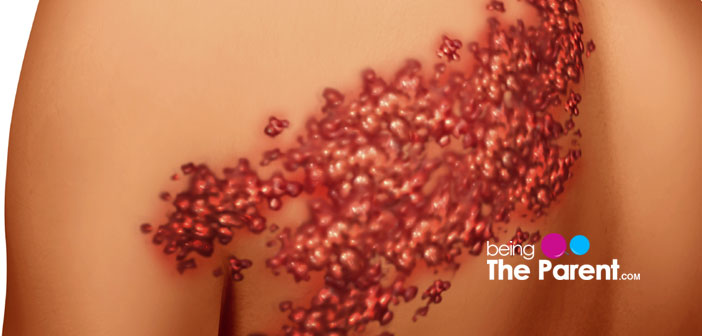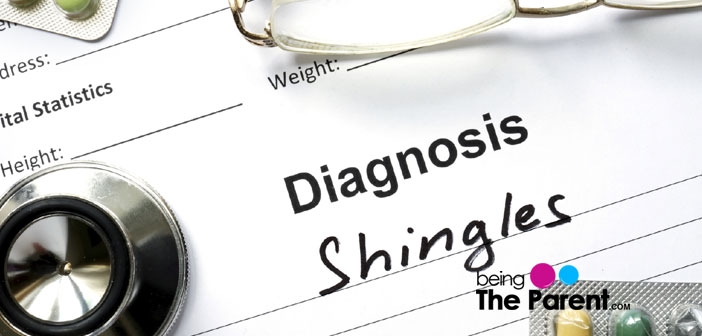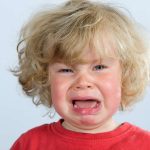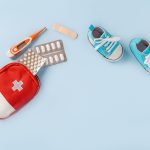
Shingles In Toddlers – Causes, Symptoms, And Treatment
5 min readWritten by Editorial Team

Shingles in toddlers are common. Every child gets sick now and then. Toddlers are prone to different types of viral infections as they have more chances of exposure to the virus which can be present in the air, water, surfaces, floors, toys, etc.. Young kids are prone to skin problems as most of them are two steps behind the cleanliness. Moreover, they have an under-developed immune system. Actually, their immune system will reach the optimum level by battling with the viruses, bacteria, germs and other disease-causing organisms. In this article, we give you a picture of a viral infection (though are more common among older people) that affect the children – shingles. Find out everything about Causes, Symptoms, And Treatment for Shingles In Toddlers

- What Is Shingles?
- Do Toddlers Get Affect By Shingles?
- Is Shingles Contagious?
- What Are The Symptoms Of Shingles?
- When Should You Seek Medical Attention?
- How Do Shingles Get Diagnosed?
- Can We Prevent Shingles In Toddlers?
What Is Shingles?
Shingles is a viral disease that causes an agonizing skin rash. In spite of the fact that shingles can happen at any place on the body, it frequently shows up as a solitary stripe of small bubbles on the skin filled with the serum that wraps around either the left or the right half of the trunk.
Shingles are created by a virus called varicella-zoster. It is the same virus that causes chickenpox. After an individual has chickenpox, shingles most commonly affect older people. This happens when infection lies idle (inactive) in nerve tissue close to his spinal cord and brain. A long time later, the infection may reactivate as shingles (though the reason behind this reactivation is still not clear).
Do Toddlers Get Affect By Shingles?
Shingles, generally affect older people who already had an attack of chickenpox earlier in their life. Also, the blisters will be very painful in that severe mode of shingles. The chance of a child under three years old getting shingles are very rare. This is because their immune system has been empowered a little while back by the actual chickenpox. Remember that the shingles happen only after a chickenpox attack. That too, after a (relatively) long break. Even if they get shingles, the severity and pain are found to be much less than that of an older person.
Is Shingles Contagious?
Yes. Shingles are highly contagious. Unlike chickenpox, shingles cannot be caught by sharing a room as the virus is not passed through the air. It will, on the other hand, pass through the contact with the watery substance within the blisters. But note that, when shingles pass to a child who doesn’t have chickenpox or the chickenpox vaccination, what he will get is chickenpox, not shingles.
What Are The Symptoms Of Shingles?
As the shingles affect a particular nerve, it generally affects a small area of either one of the sides of the child’s body, unlike the chicken pox which spread all over the body.
- The primary sign of shingles will be shivering, tingling, and agony in the zone where the rash is going to show up. This can be disappointing as your little one may feel irritated, yet you’ll have no clue what’s bringing it on
- A couple of days after the primary signs, fluid-filled blisters like chickenpox spots break out on the skin taking after the pathway of the nerve. The blisters are just in the zone that the nerve goes to, and can be in the form of a band
- Headache, fever, tiredness, general body aches is found to accompany the blisters in some children
- These watery blisters will start to break open and begin to dry (scab) by around ten days
- Once the blisters are scabbed over, the healing process starts and all the scabs will fall off in about two weeks or at the most within a month after the rashes appear

When Should You Seek Medical Attention?
It is important to know Causes, Symptoms, And Treatment for Shingles In Toddlers. In most instances, shingles will heal on their own with or without the treatment. But make sure your child gets immediate medical assistance-
- If the rashes appear on the face: There are chances for the rashes to spread to the eyes, which can damage the vision of the child badly. Your child’s doctor will take measures to keep the infection from spreading to the eyes
- If the child is under immuno-suppressive medication: For any cause, if your child is taking medicines to suppress the immunity or if he is already suffering from some chronic health issues, once the signs of shingle surfaces make sure to seek immediate medical attention for your child
- If your child possesses a weakened immune system: Complications such as superficial skin infections like impetigo can happen if your child’s immune system is weak. Other nerve-related problems like facial paralysis, balance disorder, and hearing problems can also happen. In some extreme and rare cases, inflammation of the brain is also reported
- Painful rashes: If the child complains the rashes is very painful and itchy
- No sign of heal: If the rashes show no sign of clearing up even after 14 days
How Do Shingles Get Diagnosed?
For the most part, a specialist can analyze shingles just by looking at the rash and rankles. In odd cases, the specialist may expel a little example of the infected tissue to be inspected in a research center.
What Is The Treatment For Shingles In Toddlers?
Not all children who get shingles need treatment. Be that as it may, if the specialist chooses a treatment may help, it ought to be begun without delay. The earlier the treatment, more effective the treatment will be and also possess less risk. The treatment usually involves:
- Antiviral drugs: Though antiviral drugs are not able to eliminate the virus from the body of the child, it can certainly reduce the chances of complications and accelerate the healing process
- Ointments and creams: There are certain ointments and creams, which, if applied to the infected area, reduce the itching and pain associated with shingles. Some sprays are also prescribed to numb your child’s infected skin to reduce the pain
Other measures include-
- Make the child take rest: Encourage the child to take a rest. This will also help the infection from spreading to other members of the family, especially the grandparents
- Keep the blisters uncovered: Keep the blisters uncovered as long as possible. As they heal faster when they are open to air
- Keep clean: Keep the affected area clean. You can use water and mild soap to clean the infected area
- Compressors: Applying cool or wet compressors in the affected area can give your child a soothing feeling
- Never pick the scabs: Never let the child pick the scab as it can cause infection
Can We Prevent Shingles In Toddlers?
Shingles cannot be prevented completely. But the chickenpox vaccine is found to reduce the impact of the shingles in toddler (when compared with the toddler doesn’t have a vaccination against chickenpox). Avoiding any contact with the persons who have shingles is a good preventive measure.
Hope this information about Causes, Symptoms, And Treatment for Shingles In Toddlers is helpful. Happy parenting.

Editorial Team,
With a rich experience in pregnancy and parenting, our team of experts create insightful, well-curated, and easy-to-read content for our to-be-parents and parents at all stages of parenting.Read more.
Responses (0)
Want curated content sharply tailored for your exact stage of parenting?
Related articles

Top 8 Easy Painting Activities For Toddlers

Top Interesting Activities For Toddlers to Do at Home

Gluten-Free Casein-Free (GFCF) Diet For Autistic Kids

Common Genital Problems in Toddlers

Toddler Whining – Everything You Need to Know About it

Toddler First Aid Kit Essentials – Be Prepared For Emergencies
Sponsored content
Discover great local businesses around you for your kids.
Get regular updates, great recommendations and other right stuff at the right time.





